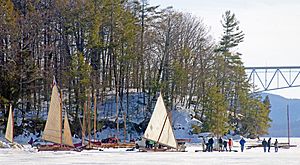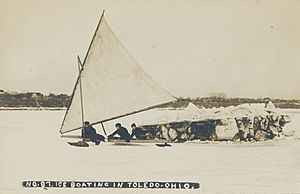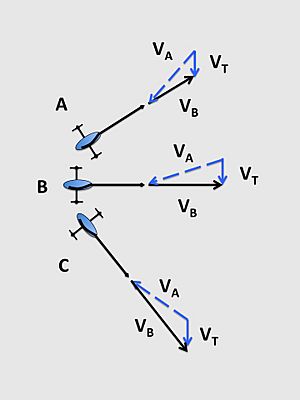Bay scooter facts for kids
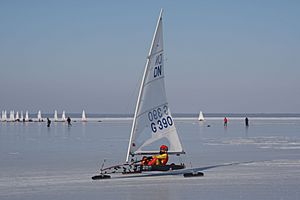
An iceboat is a cool sailing craft that glides super fast over ice! Think of it like a sailboat, but instead of floating on water, it rides on sharp metal blades called "runners." One of these runners can be steered, helping the iceboat turn.
Long ago, iceboats looked more like regular boats with runners underneath. But over time, they changed into sleek frames with a seat for the sailor. The steering also moved from the back to the front. Because iceboats slide easily on ice, they can go incredibly fast, often over 60 miles per hour (97 km/h)! People use them for fun and for exciting races. Most racing iceboats are designed for just one person.
There's a similar sport called land sailing, where special vehicles with sails ride on wheels instead of runners.
Contents
History of Iceboats
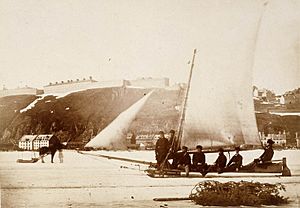
Iceboating first started in Europe, especially in places like the Baltic Sea and the canals of the Netherlands. People used these early iceboats for carrying goods. But soon, they became popular for fun and racing, known as "ice yachts."
The sport then came to North America, where it really took off.
Where Iceboating Grew
Iceboating was first recorded in the 1600s on the frozen Gulf of Riga and Dutch canals. These early iceboats helped transport cargo.
In 1790, the first iceboats appeared in the United States on New York's Hudson River. This is where the sport truly became popular. The very first recorded iceboat was built by Oliver Booth in 1790. It was a simple box on three runners, with one runner at the back for steering. This made the sport open to many people.
By the mid-1800s, two main ice yachting clubs formed on the Hudson River. Wealthy boat owners had huge iceboats, some as long as 69 feet (21 m), with up to seven crew members! These giant iceboats could reach amazing speeds. In 1885, a boat called the Icicle set a record of 107 miles per hour (172 km/h), which was faster than any other vehicle at the time!
Iceboat races became very exciting. In 1881, the first American Challenge Pennant race took place on the Hudson River. Five ice yacht clubs competed on a triangular course. Iceboats were grouped into different classes based on their sail size.
By the early 1900s, iceboating had spread to other parts of the US, like Minnesota, Wisconsin, and Michigan. It also became popular in Canada, on Lake Ontario and the Saint Lawrence River. In Europe, an ice sailing club formed in Sweden in 1901. Later, the European Ice Yachting Union was created in 1928, with countries like Latvia, Estonia, and Germany joining.
How Iceboats Changed Over Time
In the 1600s, Dutch ice yachts were flat-bottomed sailboats placed on a wide plank with metal runners. A steering runner at the back helped guide them. These boats used traditional sails, like those on water sailboats.
In the 1800s, iceboats became more like a box on cross-pieces, supported by runners. These "stern-steerer" boats were usually rigged with two sails, a main sail and a smaller jib sail at the front. By 1879, the classic Hudson River iceboat design appeared. These boats had a single main beam and strong wires to hold everything together. The mast was moved forward, and the sails were balanced for better speed. Some of these large stern-steerers were still used even in the late 1900s.
In the early 1900s, smaller iceboats called scooters were invented. These could travel on both ice and water! They had a shallow, oval hull and fixed runners. They were steered by moving the sails, as they didn't have a rudder.
Around the 1930s, a big change happened. Iceboats started to be steered from the front instead of the back. Walter Beauvois designed a front-steering boat called the Beau Skeeter. This led to the popular "Skeeter" class of iceboats. The Skeeter class boats are very sleek and fast, often having a mosquito logo on their sails. They are limited to a sail area of 75 square feet (7 m²).
In 1937, The Detroit News newspaper sponsored a contest for a new iceboat design that people could build at home. This design became the famous International DN class. Later, in 1968, the Nite class was designed, and these boats started being made from fiberglass in the 1970s.
How Fast Do Iceboats Go?
Modern iceboats usually have a triangular or cross-shaped frame with three sharp runners. The steering runner is at the front. These runners are made of iron or steel and have very sharp edges. They grip the ice, stopping the boat from sliding sideways when the wind pushes the sails.
Because there's so little friction on ice, iceboats can go incredibly fast – up to five times faster than the actual wind! This is because of something called "apparent wind." When the iceboat moves quickly, the wind you feel (apparent wind) comes mostly from the direction the boat is traveling. This means the sail is almost always pulled tight, helping the boat go even faster.
Top Speeds
Different types of iceboats can reach different speeds:
- The International DN class can go between 55-68 miles per hour (89-109 km/h).
- Skeeter class iceboats can reach speeds of 84 miles per hour (135 km/h).
- Older, classic iceboats were said to go as fast as 140 miles per hour (225 km/h) in the early 1900s! However, it's hard to know for sure if they could really go that fast or measure it accurately back then.
Race Courses
Because iceboats are so fast, their race courses are set up in a special way. They usually involve going in a straight line upwind and then downwind. This means sailors have to do a lot of tacking (turning into the wind) and jibing (turning away from the wind) to get around the course safely.
Types of Iceboats (Classes)
There are several popular types, or "classes," of iceboats. Many have special clubs in Europe and North America. Some well-known classes include the IceOptimist, International DN, and Monotype XV. Other classes, like the Nite, Renegade, and Skeeter, are more common in North America.
-
International DN class iceboats at the start of a race in Znin, Poland
IceOptimist
The IceOptimist is a special iceboat for young sailors. It uses the same sails and rigging as the International Optimist dinghy, a popular sailboat for kids. The first design was built in Estonia in 1978. Since 2002, the class has held World and European Championships each winter, with about 40 young racers competing.
International DN
The International DN is the most popular iceboat class in both North America and Europe. It's a wooden boat, 12 feet (3.7 m) long, with a cross-plank 8 feet (2.4 m) long. The mast is 16 feet (4.9 m) high. Modern DNs often use flexible masts made from special lightweight materials. The "DN" in its name comes from The Detroit News, which asked for a high-performance, affordable, home-built iceboat design in 1937. Modern DNs still look a lot like the original design and have 60 square feet (5.6 m²) of sail.
Monotype XV
The Monotype XV is a stern-steering iceboat, meaning it's steered from the back. It was designed in 1932 by Erik von Holst from Estonia. This boat can be sailed by one or two people. It's built to very strict rules, which haven't changed much since the 1930s. It's the biggest one-design iceboat class in Europe and the only international double-handed (two-person) iceboat class. It weighs 205 kg (452 lb) and is 7.5 meters (25 ft) long and 4.2 meters (14 ft) wide, with a 7.2-meter (24 ft) high mast.
Nite
The Nite is an iceboat class with a two-seat fiberglass body, where two people sit side-by-side. It has a 67-square-foot (6.2 m²) sail and is built to very specific rules.
Renegade
The Renegade is a class of iceboat that people can build at home. It was designed in 1947 by Elmer Millenbach in Wisconsin. The idea was to create an iceboat that could be easily carried on top of a car. Its plans were published in 1950. It has a 67-square-foot (6.2 m²) sail on a flexible, aerodynamic mast.
Skeeter
The Skeeter class is divided into different groups (A, B, and C), but all are limited to 75 square feet (7 m²) of sail area. A-class boats can be for one or two people sitting one behind the other. Their mast can be up to 28.5 feet (8.7 m) high, and they can use lightweight carbon fiber in their construction. B-class boats have seats for two people sitting side-by-side. C-class Skeeters can be for one or two people, with a mast no taller than 20.25 feet (6.17 m).
See also


